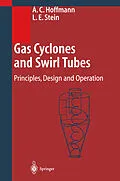The subject of this book is centrifugal gas separation devices, namely cyclones used for gas purification, solids collection and for demisting. The optimization of cyclone performance for any given task is an often-sought goal but is seldom achieved in practice. Understanding cyclone performance as a function of a cyclone's size, geometry, feed properties, feed flow rates and the system of which it is a part, is essential if one wishes to successfully design, operate, troubleshoot or predict cyclone performance. The information presented in this expanded book edition will help to develop this understanding.
Klappentext
This book has been conceived to provide guidance on the theory and design of cyclone systems. Forthose new to the topic, a cyclone is, in its most basic form, a stationary mechanical device that utilizes centrifugal force to separate solid or liquid particles from a carrier gas. Gas enters near the top via a tangential or vaned inlet, which gives rise to an axially descending spiral of gas and a centrifugal force field that causes the incoming particles to concentrate along, and spiral down, the inner walls of the separator. The thus-segregated particulate phase is allowed to exit out an underflow pipe while the gas phase constricts, and - in most separators - reverses its axial direction of flow and exits out a separate overflow pipe. Cyclones are applied in both heavy and light industrial applications and may be designed as either classifiers or separators. Their applications are as plentiful as they are varied. Examples include their use in the separation or classification of powder coatings, plastic fines, sawdust, wood chips, sand, sintered/powdered meta!, plastic and meta! pellets, rock and mineral cmshings, carbon fines, grain products, pulverized coal, chalk, coal and coal ash, catalyst and petroleum coke fines, mist entrained off of various processing units and liquid components from scmbbing and drilling operations. They have even been applied to separate foam into its component gas and liquid phases in recent years.
Inhalt
Introduction.- Basic Ideas.- How Cyclones Work.- Cyclone Flow Pattern and Pressure Drop.- Cyclone Separation Efficiency.- The Muschelknautz Method of Modeling.- Computational Fluid Dynamics.- Dimensional Analysis and Scaling Rules.- Other Factors Influencing Performance.- Measurement Techniques.- Underflow Configurations and Considerations.- Some Special Topics.
